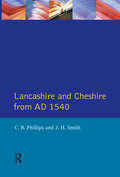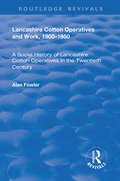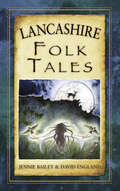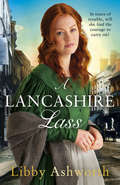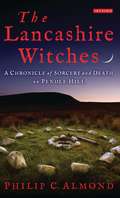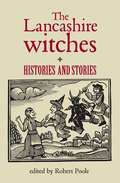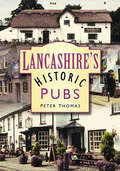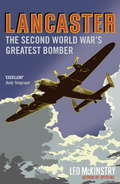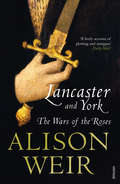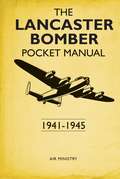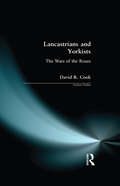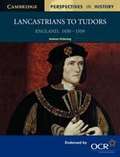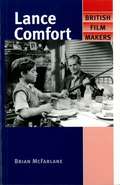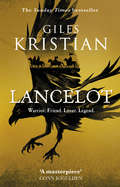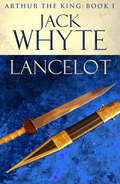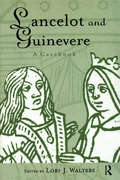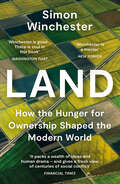- Table View
- List View
Lancashire and Cheshire from AD1540
by C. B. Phillips J. H. SmithFirst published in 1994. Routledge is an imprint of Taylor & Francis, an informa company.
Lancashire and Cheshire from AD1540
by C. B. Phillips J. H. SmithFirst published in 1994. Routledge is an imprint of Taylor & Francis, an informa company.
Lancashire Cotton Operatives and Work, 1900-1950: A Social History of Lancashire Cotton Operatives in the Twentieth Century
by Alan FowlerThis title was first published in 2003. The cotton industry was one of the major motors that powered Britain's industrial development from the mid-eighteenth century, contributing in no small way to the revolution that was to transform Europe over the next hundred years. The combination of technological developments, colonial exploits and social transformation that all came together in the Lancashire cotton industry provided a perfect example of how the new world would function, its priorities and its ambitions. Into this fast moving and fluid situation, were thrust the men, women and children who formed the vast pool of labour necessary to keep the spindles and looms running. It is their experiences above all, that illuminates the history of the cotton industry, and how it came to change the face of Britain through the nineteenth and early twentieth centuries. In this study, Alan Fowler takes an in-depth look at the Lancashire cotton industry through the prism of its workers, their families and organisations. He argues that by 1850 the triumph of the factory system was complete, and the factory operative a mainstay of a transformed society based on a new economic order. With this increasingly important role in the new economy came opportunities, which cotton workers were not slow to grasp. Crucial to the history of the Lancashire cotton operatives were the collective organisations they established which forced employers and government to treat with them. By the beginning of the twentieth century these organisations had managed to raise wages, improve working conditions, reduce working hours, establish the right to holidays, and force the introduction of factory legislation. This book explores how these victories were won and the impact they had on the industry and wider society.
Lancashire Cotton Operatives and Work, 1900-1950: A Social History of Lancashire Cotton Operatives in the Twentieth Century
by Alan FowlerThis title was first published in 2003. The cotton industry was one of the major motors that powered Britain's industrial development from the mid-eighteenth century, contributing in no small way to the revolution that was to transform Europe over the next hundred years. The combination of technological developments, colonial exploits and social transformation that all came together in the Lancashire cotton industry provided a perfect example of how the new world would function, its priorities and its ambitions. Into this fast moving and fluid situation, were thrust the men, women and children who formed the vast pool of labour necessary to keep the spindles and looms running. It is their experiences above all, that illuminates the history of the cotton industry, and how it came to change the face of Britain through the nineteenth and early twentieth centuries. In this study, Alan Fowler takes an in-depth look at the Lancashire cotton industry through the prism of its workers, their families and organisations. He argues that by 1850 the triumph of the factory system was complete, and the factory operative a mainstay of a transformed society based on a new economic order. With this increasingly important role in the new economy came opportunities, which cotton workers were not slow to grasp. Crucial to the history of the Lancashire cotton operatives were the collective organisations they established which forced employers and government to treat with them. By the beginning of the twentieth century these organisations had managed to raise wages, improve working conditions, reduce working hours, establish the right to holidays, and force the introduction of factory legislation. This book explores how these victories were won and the impact they had on the industry and wider society.
Lancashire Folk Tales (Folk Tales Ser.)
by David England Jennie Ruth BaileyThese lively and entertaining folk tales from one of Britain’s most diverse counties are vividly retold by writer, storyteller and poe t Jennie Bailey and storyteller, writer,psychotherapist and shamanic guide David England. Take a fantasy journey around Lancashire, the Phantom Voice at Southport, the Leprechauns of Liverpool and the famous hanging of Pendle Witches at Lancaster,to the infamous Miss Whiplash at Clitheroe. Enjoy a rich feast of local tales, a vibrant and unique mythology,where pesky boggarts, devouring dragons, villainous knights,venomous beasts and even the Devil himself stalk the land. Beautifully illustrated by local artists Jo Lowes and Adelina Pintea, these tales bring to life the landscape of the county’s narrow valleys, medieval forests and treacherous sands.
A Lancashire Lass (The Mill Town Lasses)
by Libby AshworthTHE SECOND NOVEL IN THE INSPIRATIONAL MILL TOWN LASSES SERIES. Perfect for fans of Val Wood and Catherine Cookson.______________________Lancashire, 1832Maids Hannah and Mary find themselves with no jobs and no home when their employer, Henry Sudell, loses all his money and disappears in the middle of the night. They have no choice but to return to Blackburn where Hannah is lucky to be taken in by her sister Jennet and brother-in-law, Titus, but Mary must seek lodgings in the infamous Star beer house.Mary tries to get her job back as a weaver, but the influx of workers from the countryside and no support for the working class means that jobs are scarce. With no other choice she remains at the beer house, forced to risk her reputation and even her life.In the middle of a cholera outbreak and political upheaval, can Mary ever find a way to recover all she's lost?______________________Praise for Libby Ashworth'An engrossing tale of hardship, struggles, love and family' Kitty Neale'Vividly drawn characters . . . gritty and heartfelt' Evie Grace'Brimming with drama, heartbreak, love, friendship and the powerful bonds of family' Lancashire Post
The Lancashire Witches: A Chronicle of Sorcery and Death on Pendle Hill (International Library Of Historical Studies #Vol. 82)
by Philip C. AlmondIn the febrile religious and political climate of late sixteenth-century England, when the grip of the Reformation was as yet fragile and insecure, and underground papism still perceived to be rife, Lancashire was felt by the Protestant authorities to be a sinister corner of superstition, lawlessness and popery. And it was around Pendle Hill, a sombre ridge that looms over the intersecting pastures, meadows and moorland of the Ribble Valley, that their suspicions took infamous shape. The arraignment of the Lancashire witches in the assizes of Lancaster during 1612 is England's most notorious witch-trial. The women who lived in the vicinity of Pendle, who were accused alongside the so-called Samlesbury Witches, then convicted and hanged, were more than just wicked sorcerers whose malign incantations caused others harm. They were reputed to be part of a dense network of devilry and mischief that revealed itself as much in hidden celebration of the Mass as in malevolent magic. They had to be eliminated to set an example to others. In this remarkable and authoritative treatment, published to coincide with the 400th anniversary of the case of the Lancashire witches, Philip C Almond evokes all the fear, drama and paranoia of those volatile times: the bleak story of the storm over Pendle.
The Lancashire Witches: Histories and Stories (PDF)
by Robert PooleThis book is the first major study of England's biggest and best-known witch trial which took place in 1612, when ten witches were arraigned and hung in the village of Pendle in Lancashire. The book has equal appeal across the disciplines of both History and English Literature/Renaissance Studies, with essays by the leading experts in both fields. Includes helpful summaries to explain the key points of each essay. Brings the subject up-to-date with a study of modern Wicca and paganism, including present-day Lancashire witches. Quite simply, this is the most comprehensive study of any English witch trial.
The Lancashire witches: Histories and stories
by Robert PooleThis book is the first major study of England's biggest and best-known witch trial which took place in 1612, when ten witches were arraigned and hung in the village of Pendle in Lancashire. The book has equal appeal across the disciplines of both History and English Literature/Renaissance Studies, with essays by the leading experts in both fields. Includes helpful summaries to explain the key points of each essay. Brings the subject up-to-date with a study of modern Wicca and paganism, including present-day Lancashire witches. Quite simply, this is the most comprehensive study of any English witch trial.
Lancashire's Historic Pubs
by Peter ThomasIf you enjoy the occasional pub meal, a drink at the bar, or if you're interested in Lancashire's social history, you're sure to find something entertaining in Peter Thomas's introduction to the county's pubs. It opens with a round-up of the history of brewing, pubs and ale-selling, and a section on Lancashire's pub signs, though most of the book is dedicated to an A-Z of over fifty of the most interesting inns. Their history, architecture, ghosts and associated legends are all featured, as well as the exploits of their famous and infamous landlords and landladies. Peter's exhaustive research has resulted in a gem of a book which brings together the proud history, traditions and customs associated with Lancashire hostelries; from ale tasting at the Plough at Eaves to the Britannia Coconut Dancers at the Crown Inn at Bacup. A fascinating journey, with plenty of refreshment stops along the way, this will appeal to anyone with an interest in local history, and those who'd like to know more about the convival surroundings in which they might enjoy a pint.
Lancaster: The Second World War's Greatest Bomber
by Leo McKinstryThe Spitfire and the Lancaster were the two RAF weapons of victory in the Second World War, but the glamour of the fighter has tended to overshadow the performance of the heavy bomber. Yet without the Lancaster, Britain would never have been able to take the fight to the German homeland. Highlights the scale of the bomber’s achievements, including the famous Dambusters attacks. With its vast bomb bay, ease of handling and surprising speed, the mighty Lancaster transformed the effectiveness of the Bomber Command. Whilst addressing the political controversy surrounding the bombing offensive against Germany, Leo McKinstry also weaves individual tales into this compelling narrative. Rich characters are brought to life, such as Roy Chadwick the designer, who taught himself engineering at night school and Sir Arthur Harris, the austere head of the Bomber Command. This is a rich saga, a story of triumph over disaster and the history of an iconic plane.
Lancaster
by Bloomsbury PublishingThe star of the famous 'Dambusters' raid, the Avro Lancaster also formed the backbone of the RAF's Bomber Command during the large-scale night bombing campaign against occupied Europe during World War II. Unable to hit back on the ground, with the Lancaster, Britain could take the fight to Germany. This complete illustrated guide to one of Britain's most iconic aircraft explores its history, strengths, weaknesses and combat performance in the war that would make it legendary. Featuring stunning artwork and contemporary photographs, this book reveals how the Lancaster became the RAF's most successful heavy bomber of the war, and a symbol of British resistance and air power.
Lancaster
by Bloomsbury PublishingThe star of the famous 'Dambusters' raid, the Avro Lancaster also formed the backbone of the RAF's Bomber Command during the large-scale night bombing campaign against occupied Europe during World War II. Unable to hit back on the ground, with the Lancaster, Britain could take the fight to Germany. This complete illustrated guide to one of Britain's most iconic aircraft explores its history, strengths, weaknesses and combat performance in the war that would make it legendary. Featuring stunning artwork and contemporary photographs, this book reveals how the Lancaster became the RAF's most successful heavy bomber of the war, and a symbol of British resistance and air power.
Lancaster And York: The Wars of the Roses
by Alison WeirThe war between the houses of Lancaster and York for the throne of England was characterised by treachery, deceit and - at St Albans, Blore Hill and Towton, - some of the bloodiest and most dramatic battles on England's soil. Between 1455 and 1487 the royal coffers were bankrupted and the conflict resulted in the downfall of the houses of Lancaster and York and the emergence of the illustrious Tudor dynasty. Alison Weir's lucid and gripping account focuses on the human side of history, on the people and personalities involved in the conflict. At the centre of the book stands Henry VI, the pious king whose mental instability led to political chaos, Richard Plantagenet, Duke of York and Henry's rival, and most important of all, Margaret of Anjou, Henry's wife who took up her arms in her husband's cause and battled for many years in a violent man's world.
The Lancaster Bomber Pocket Manual: 1941-1945 (Military Manuals Ser.)
by Martin RobsonThe Avro Lancaster was the RAF's most famous and successful heavy bomber of the Second World War. Used predominantly at night, 'Lancs' dropped 608,612 tons of bombs in 156,000 sorties in the period 1942-1945. Some of these missions were incredibly daring – notably the 'dambusters' raid of 617 squadron on the Ruhr valley dams in May 1943. The success of such operations was testament both to the rugged, reliable qualities of this amazing aircraft and the bravery and skill of the pilots, navigators, bombardiers, flight engineers and gunners that crewed it. They relied on their training and experience, supplemented by various pamphlets and manuals that were produced throughout the war. Supplemented with illustrative plans and diagrams, this fascinating pocket manual provides a unique insight into the wartime operation of this famous aircraft.
Lancastrians and Yorkists: The Wars of the Roses (Seminar Studies)
by D. R. CookThis concise, lucid study charts the complex sequence of events we know today as the War of the Roses. In the thematic chapters of the third section the author assesses the motives and relationships of the principal actors; the real character and impact of the Wars of the Roses; and the nature of Yorkist government.
Lancastrians and Yorkists: The Wars of the Roses (Seminar Studies)
by D. R. CookThis concise, lucid study charts the complex sequence of events we know today as the War of the Roses. In the thematic chapters of the third section the author assesses the motives and relationships of the principal actors; the real character and impact of the Wars of the Roses; and the nature of Yorkist government.
Lancastrians To Tudors: England 1450-1509 (PDF) (Cambridge Perspectives In History Ser.cambridge Perspectives In History Core Texts Series)
by Andrew Pickering Richard Brown David SmithAn engaging range of period texts and theme books for AS and A Level history. The Wars of the Roses and the struggle for the throne between the Houses of York and Lancaster dominate the history of England in the latter half of the fifteenth century. But what were the causes of over forty years of sporadic civil war and how was political stability at last restored? Andrew Pickering aanalyses the historical debates surrounding the characters and events. Topics include fifteenth-century kingship and the reign of Henry VI, the end of the Yorkists, Henry VII and the establishment of the Tudor dynasty, and social and economic change in the late fifteenth and early sixteenth centuries.
Lance Comfort (British Film-Makers)
by Brian McFarlaneIn the years between 1941 and 1965, Lance Comfort made some of the most entertaining films in Britain. There was the striking success of his second feature as director, Hatter’s Castle (1941) and when he returned to this melodramatic vein in 1945 he made a series of highly proficient and enjoyable studies in obsession, including Bedelia (1946) with Margaret Lockwood as a murderess, and Temptation Harbour (1947) starring Robert Newton as a decent man in the grip of erotic attraction. Comfort’s career has never been charted in full – that is, from the apprenticeship in the 1930s, through the melodramas of the 1940s to the often rewarding co-features of the following two decades. His is in many ways a prototypical career in British cinema: his very attractive body of work has been marginalised by critical focus on a few giant figures. This is a book that will appeal to all students and researchers in British cinema, as well as to anyone with an interest in British films – and why they were the way they were – in their most productive period.
Lancelot: The Betrayal
by Giles KristianConn Iggulden has called it 'a masterpiece' while The Times has hailed it 'a gorgeous, rich retelling of the Arthurian tale' . . . The legions of Rome are a fading memory. Enemies stalk the fringes of Britain. And Uther Pendragon is dying. Into this fractured and uncertain world the boy is cast, a refugee from fire, murder and betrayal. An outsider whose only companions are a hateful hawk and memories of the lost. Yet he is gifted, and under the watchful eyes of Merlin and the Lady Nimue he will hone his talents and begin his journey to manhood. He will meet Guinevere, a wild, proud and beautiful girl, herself outcast because of her gift. And he will be dazzled by Arthur, a warrior who carries the hopes of a people like fire in the dark. But these are times of struggle and blood, when even friendship and love seem doomed to fail. The gods are vanishing beyond the reach of dreams. Treachery and jealousy rule men’s hearts and the fate of Britain itself rests on a sword’s edge.But the young renegade who left his home in Benoic with just a hunting bird and dreams of revenge is now a lord of war. He is a man loved and hated, admired and feared. A man forsaken but not forgotten. He is Lancelot.Set in a 5th century Britain besieged by invading bands of Saxons and Franks, Irish and Picts, Giles Kristian's epic new novel tells - in Lancelot's own words - the story of the most revered yet reviled of all Arthur's knights, the warrior who fought at his lord's side - yet stole his wife. This is the story of the of one of the great figures of British myth and legend - a story ready to be re-imagined for our times.
Lancelot: Legends of Camelot 4 (Arthur the King – Book I) (Arthur the Hero #4)
by Jack WhyteA mighty warriorA faithful friendAn immortal loveAs Arthur forges a union in Britain, across the sea a royal son is denied his birthright. The Romans are gone and war is coming to Gaul.In an age of cruelty and barbarism, Lancelot - known as Clothar - has been raised to champion justice and righteousness, but as his boyhood world in Gaul disintegrates, he seeks sanctuary in a new home: Britain.There he finds Arthur Pendragon, newly crowned High King, who, dreams, like Clothar himself, of living in a better world. The friendship of these men, and the love they share for a woman, will grow into Britain's most enduring legend.Discover the most authentic telling of the Arthurian legend ever written
Lancelot and Guinevere: A Casebook (Arthurian Characters and Themes)
by Lori J. WaltersBeginning with an introduction that examines the portrayal of the characters of Lancelot and Guinevere from their origins to the present day, this collection of 16 essays-five of which appear here for the first time-puts particular emphasis on the appearance of the two characters in medieval and modern literature. Besides several studies exploring feminist concerns, the volume features articles on the representation of the lovers in medieval manuscript illuminations (18 plates focus on scenes of their first kiss and the consummation of the adultery), in film, and in other visual arts. A 200-item bibliography completes the volume.
Lancelot and Guinevere: A Casebook (Arthurian Characters and Themes #Vol. 4)
by Lori J. WaltersBeginning with an introduction that examines the portrayal of the characters of Lancelot and Guinevere from their origins to the present day, this collection of 16 essays-five of which appear here for the first time-puts particular emphasis on the appearance of the two characters in medieval and modern literature. Besides several studies exploring feminist concerns, the volume features articles on the representation of the lovers in medieval manuscript illuminations (18 plates focus on scenes of their first kiss and the consummation of the adultery), in film, and in other visual arts. A 200-item bibliography completes the volume.
Land: How The Hunger For Ownership Shaped The Modern World
by Simon WinchesterFrom the bestselling author Simon Winchester, a human history of land around the world: who mapped it, owned it, stole it, cared for it, fought for it and gave it back.
